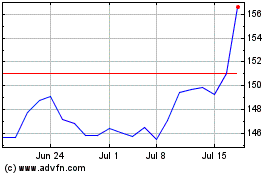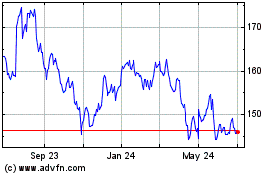J&J Shakes Off Pricing Pressure, Plans Cost Cuts -- WSJ
April 18 2018 - 3:02AM
Dow Jones News
By Jonathan D. Rockoff and Imani Moise
This article is being republished as part of our daily
reproduction of WSJ.com articles that also appeared in the U.S.
print edition of The Wall Street Journal (April 18, 2018).
Johnson & Johnson reported higher-than-expected sales in its
latest quarter and boosted its sales outlook for the year despite
ongoing pricing pressures for its prescription drugs and medical
devices.
J&J said it planned to cut costs in its supply chain by $600
million to $800 million a year by 2022. To carry out the changes,
J&J expects it will take $1.9 billion to $2.3 billion in
charges over the next several years.
The New Brunswick, N.J., company said it planned to invest more
than $30 billion in capital projects and research-and-development
in the U.S. through 2021, 15% more than the company invested over
the previous four years. The company said U.S. tax reform played a
role in the increase.
Chief Financial Officer Dominic Caruso played down the prospects
of J&J making a major pharmaceutical acquisition, indicating
the company would probably rely instead on its strong pipeline of
new drugs and its collaborations with other companies.
J&J is one of the biggest health-products companies in the
world by sales, and Wall Street considers its results a harbinger
for the rest of the health-care industry.
The company upped its financial forecast for the year largely
because of the performance of its pharmaceutical business, Mr.
Caruso said. Sales of key drugs like cancer therapies Darzalex and
Imbruvica rose by double digits in the quarter.
J&J now expects 2018 sales of $81 billion to $81.8 billion
and earnings in the range of $8 to $8.20 a share.
"We're off to a strong start this year," Mr. Caruso said in a
conference call with analysts and investors.
Pricing and competitive pressures remain a threat. In March,
J&J reported the average price paid for its medicines in the
U.S. fell by 4.6% last year due to the company's discounts. The
company said it expected competition in the pharmaceutical business
to continue throughout the year.
During the quarter, world-wide sales of autoimmune therapy
Remicade, the company's top-selling product, fell 16.9% as a result
of competition from lower-priced copies, known as biosimilars, and
J&J's own discounting.
Another of the company's top-selling drugs, prostate-cancer
treatment Zytiga, will probably face generic competition late this
year or early next year, according to J.P. Morgan.
President Trump is expected to speak next week about high drug
prices, but analysts expect proposals that won't hurt
pharmaceutical companies, such as efforts to reduce the
out-of-pocket costs borne by patients.
Pricing pressures also impacted sales of the company's spine,
trauma and knee parts, which fell in the quarter.
"We remain focused on making improvements across our medical
devices," Mr. Caruso said.
Sales in J&J's pharmaceutical business jumped 19% to $9.84
billion in the first quarter while sales in its consumer and
medical-devices segments rose 5.3% and 7.5%, respectively.
Results were bolstered by foreign exchange rates, which the
company said had a 4.2% positive impact.
Overall for the quarter the company reported a profit of $4.37
billion, or $1.60 a share, down from $4.42 billion, or $1.61 a
share, a year earlier. Excluding special items profit rose 13% to
$2.06 a share.
Revenue grew 13% to $20.01 billion. Analysts had forecast
earnings of $2.02 a share on $19.46 billion in revenue.
J&J's shares edged down 0.9% in trading on the New York
Stock Exchange. Before Tuesday, the stock had fallen 5.7% for the
year, while the S&P 500 has gained 0.2%.
Write to Jonathan D. Rockoff at Jonathan.Rockoff@wsj.com and
Imani Moise at imani.moise@wsj.com
(END) Dow Jones Newswires
April 18, 2018 02:47 ET (06:47 GMT)
Copyright (c) 2018 Dow Jones & Company, Inc.
Johnson and Johnson (NYSE:JNJ)
Historical Stock Chart
From Mar 2024 to Apr 2024

Johnson and Johnson (NYSE:JNJ)
Historical Stock Chart
From Apr 2023 to Apr 2024
